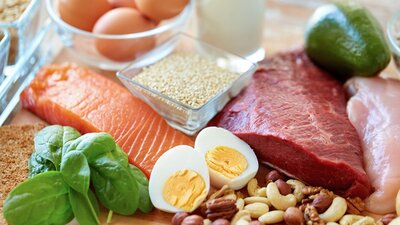Main | Training | Nutrition | Supplements | Day 1
Full-Body Weight-Loss Workouts is designed to be the solution to overcomplicated, needlessly demanding training. There's no struggling to figure out how to learn multiple complicated movements in every workout, or how to catch up from the inevitable missed workouts on a five-day or six-day split. Just click "play" on three video workouts per week and get to work.
Nutritionally, this is also a plan where basic strategies will serve you best. These include:
- Prioritizing protein, eating close to 1 gram per pound of body weight each day, split across 3-5 meals and a shake or snack.
- Eating lots of veggies, drinking lots of water, and limiting junk food.
Sound too simple to work? Of course, your results depend on your expectations—and how drastic of a change you are looking to make in your body and lifestyle. But simply eating more protein, plus an overall focus on food quality and nutrient density, can be enough for a lot of people to lose a steady, sustainable amount of weight and feel great doing it.
That said, if you'd like to use this plan as an opportunity to get more strategic about losing weight, it can definitely work! Here's how to dial in your nutrition for weight loss while following this program.
How to use the Macro Calculator
If you feel like you do better with an eye to calories and macros, Bodybuilding.com's macronutrient calculator can be an invaluable tool. No, to be clear, you don't have to weigh your food or count calories to succeed on this program, or any other. But if you've never done it before, it can be a valuable tool—even just for a few weeks—to understand portion control and ingrain some healthy behaviors.
To use it, put in your stats, select "fat loss" as the goal, and either "lightly active" or "moderately active" as your activity level. If you're doing the three weekly workouts plus some moderate cardio another 2-3 days a week, go with "moderate." If the only exercise you do for the week is the three 10-15-minute video workouts, select "lightly active."
Plug it all in and you've got your numbers! If you're totally in the dark as to how to make your meals match up to those macros, use Bodybuilding.com's guide "From Here to Macros: 4 Steps to Better Nutrition."
Looking for some simple ways to streamline your existing nutritional approach for fat loss that don't involve weighing your food? Follow these six rules while using this program.
Rule 1: Look for Easy Low-Calorie Substitutions
When you begin seeking weight loss, there's one key relationship that you need to be aware of that governs all weight change endeavors: the relationship between the number of calories you eat per day and the number of calories you burn per day. If you eat fewer calories than you burn, over time you'll lose weight. Conversely, if you eat more calories than you burn, over time you'll probably gain weight.
A lot of people will take that starting point and tell you that you need to count calories. It's not true! Instead, you can look for ways to make a single change or two to your day to begin taking in fewer calories.
This could mean:
- Swapping soda for diet soda or soda water
- Swapping juice or a sports drink for a low- or no-calorie alternative
- Swapping a bag of chips for a piece of fruit or cheese
- Swapping a candy bar for a handful of nuts and seeds
Along with a consistent workout schedule, consuming just a couple hundred fewer calories per day, when done consistently, can jump-start weight loss.
That said… you can't have a diet soda once per week and expect to make groundbreaking weight-loss progress. You need to implement your chosen strategies consistently so that your body has adequate time to react to the impact of you eating fewer calories per day.
Rule 2: Figure Out a Meal Frequency That Works for You and Stick to It
Plenty of proverbial ink gets spilled over this question: How many meals per day do I need to eat? And the answer is simple: Whatever aligns best with your lifestyle.
Seriously! When the calories and the protein intake are about the same, there's no added weight-loss benefit if you choose to eat three times or six times per day. Choose a frequency that suits your lifestyle and is sustainable in the long run for you. That's what matters most.
It's worth noting, though, that many active people find it best to eat every 3-4 hours because this helps to maintain steady energy levels throughout the day while also keeping hunger and cravings in check. This usually shapes up to three main meals and 1-2 snacks per day.
The same goes for meal timing. If you want to consume the majority of your daily intake at breakfast, or the majority in the evenings, go for it. What matters most is that your total daily intake remains more or less consistent day after day. However, as you grow on your journey and seek further progress, having some structure of meal timing may benefit you because it will allow you to optimize exercise performance and recovery, as well as better control your appetite and cravings throughout the day.
Rule 3: Think Slow and Sustainable
You do not need to commit to a super-restrictive 90-day or 12-week challenge in order to lose weight. Seriously! In fact, for many people, thinking in shorter time frames, such as 4-6 weeks will actually work better.
Most nutritionists recommend that you lose weight at a pace no faster than 0.5-1 percent of your body weight per week. Over six weeks—the length of this program—that will put you on track for around 5 percent total. For a 150-pound person, that's 7-8 pounds.
That may not sound like a lot, but it's enough of a sample size to assess and determine which changes you made worked and which didn't work. With this information, you're better able to weed out those changes that are not sustainable for you, and to focus on those that are. Then, you can put that information to work in your next 4-6 weeks.
Ultimately, this will help shape a foundation of sustainable, healthy eating habits that will serve you for a lifetime rather than feeling the need to commit to 90 days of misery only to revert back to your previous ways (and weight!) when a "challenge" is done.
Rule 4: Keep a Craving-Fighting Strategy or Two in Your Back Pocket
The easiest hunger-fighting strategy you can implement right now is to drink more (calorie-free) fluid.
When you drink fluid, it rapidly fills your stomach. When you drink a significant quantity at once, such as 8-12 ounces, it fills your tiny stomach almost completely. When this happens, the fluid forces your stomach wall to expand, which triggers a signal to be sent to the brain basically saying there's no more room left in the stomach.
The next-level strategies? Start prepping at least some of your meals (more on that soon), or at minimum, your snacks. Dial in your snack game, looking for simple meals and recipes that combine protein and nutrient-dense foods like nuts and vegetables. Have these ready so you don't find yourself ravenous when passing the drive-thru window!
Rule 5: Eat Before Your Workouts
The style of training in the Full-Body Weight-Loss Workouts is best done with a little fuel in the tank. It doesn't have to be much! Just make sure you have a little something in your stomach before a workout and pay attention to how you feel during the day.
If you're happy with your progress but feel like you don't have enough energy for your workouts, consider a piece of fruit or other quick snack 45-60 minutes before training—especially if you train in the morning.
Rule 6: Take Aim at Your "Problem Meal"
Full-on meal prep isn't an option for many people. And that's OK! But it's also true that many of us have a single "problem meal" during the day where we buy something rather than make it. Maybe lunch is your weakness, and you find yourself at the food truck several times a week. Maybe breakfast is a sugar-bomb and has been since you were a kid. Or maybe your meals are OK, but your snacks are a disaster.
No matter the case, taking the initiative to prepare your most problematic meal or snack—and just that meal or snack—can have a profound difference. And "fixing" just the most problematic meal is far easier than trying to prep all your meals, all the time—although that is definitely an option as well, if you're up for it.
For more help in losing weight and keeping it off, take a look at some of these resources:
- The Complete Guide to Losing Weight
- How to Achieve Lasting Weight Loss
- Bodybuilding.com's Foundations of Fitness Nutrition Course
- 4 Tips for Weight Loss Without Counting Macros
Main | Training | Nutrition | Supplements | Day 1

